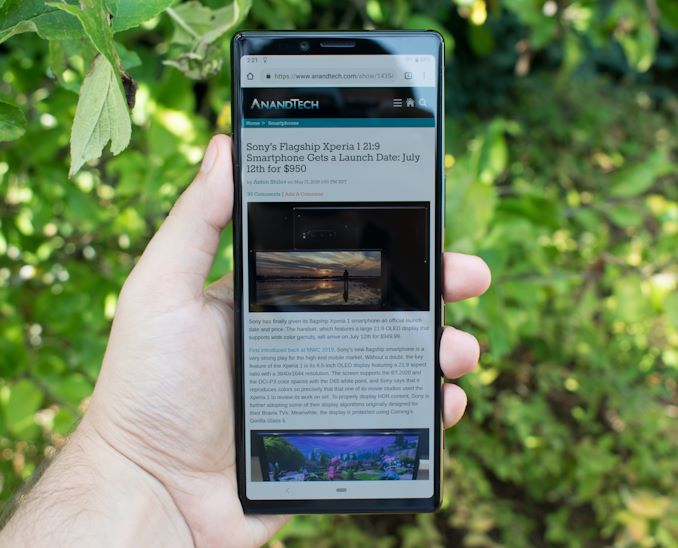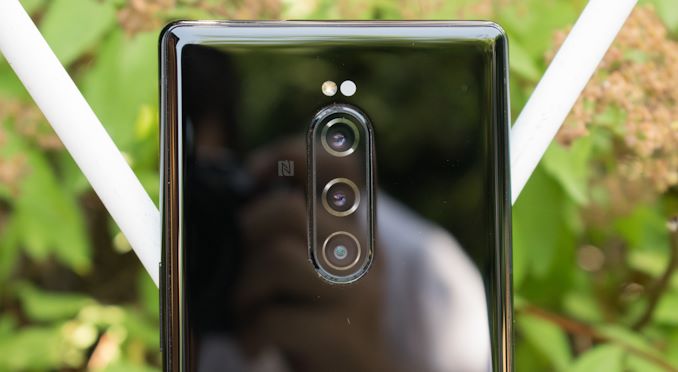The Sony Xperia 1 Review: A 21:9 Take of the World
by Andrei Frumusanu on July 26, 2019 8:00 AM EST- Posted in
- Mobile
- Sony
- Smartphones
- Xperia 1
Conclusion & End Remarks
The Xperia 1 is a very important device to Sony as it marks major changes in the company’s product strategy. While I go over the various parts of the device in the conclusion, I do have to remind reader that the phone was launched with a release price of $/€949 which currently stands quite a lot higher than other Android flagships in the market.
Design wise, I do really like the Xperia 1. Sony’s choice of differentiating themselves in the design by adopting a 21:9 screen works out really well and it is very much a different experience than other narrower aspect ratio devices. The change reminded me of the original shift from 16:9 to 18:9 phones a few years ago.
The biggest benefit here isn’t what Sony makes it out to be; although there’s some gains for video consumption and yes it does fill up native 21:9 content such as movies a lot better, I still think that’s going to be a rarity for most users – unless you’re really into watching moves on the small screen. For me personally the biggest benefit is simply having more vertical space for more content in applications, which does work very well on the Xperia 1.
The one thing that I would think would improve things even better is if Sony actually improved the navigation and maybe introduced gesture navigation to get rid of the default Android P nav bar – I still think Google majorly messed it up and it was a stupid change to make from the classical nav buttons. Sony being the only other major vendor to adopt it by default strikes me more as them not having put in the resources to customise it.
Other benefits of the device’s aspect ratio is that even though it’s a big screen and larger device, its ergonomics remain excellent as the 72mm width is at a sweet spot many users will like. The round edges of the phone are also comfortable to overall I enjoyed the Xperia 1’s in-hand feel.
The other part of the the 21:9 aspect ratio is the display panel itself. This is the first 4K OLED display in a smartphone, and I have mixed feelings about it. It’s an incredibly sharp display and you’ll notice its clarity. However while there is a difference to 1440p screens out there, I do have to question if it’s actually worth it. The fact that Sony still renders applications at 1440p and only reserves the full native resolution of the display for photos and video playback is a bit counter-intuitive, as you’d imagine text rendering being the use-case that would most benefit the higher resolution. Make no mistake, the 4K panel still improves such content even if it’s rendered in 1440p.
For the vast majority of users though I doubt anybody will actually notice the difference. Unless again you’re used to watching content very close up on your phone, you’d be hard to tell the difference to a 1440p screen at normal arm’s length distance.
Other characteristics of the display are fine – brightness and viewing angles are excellent. The colour calibration of the panel however is not. Here even though Sony promises some more professional grade features, they are quite misleading in their marketing as they don’t match up to the technical characteristics of the phone. It’s actually quite embarrassing for Sony to promote an accurate display profile yet then very evidently miscalibrate it with some noticeable gamma issues, and I had to manually set a more accurate colour temperature.
Performance of the Xperia 1 is good. The Snapdragon 855 serves as a great cornerstone of the phone and the experience is similar to that of other devices in the market, and I haven’t had issues with Sony’s implementation.
Gaming wise, even though the phone showcases some very severe CPU throttling, the GPU throttling is kept in check and still manages to perform quite well compared to other S855 devices bar the OnePlus 7 Pro – which was a bit surprising as the Xperia 1’s thermal design didn’t quite seem as good as that of other phones.
Battery life is a major negative for the phone. Here there’s a double-whammy of a power consuming display as well as a smaller battery that lands the Xperia 1 amongst the bottom of our charts. The 4K resolution screen here is just another negative that maybe wasn’t needed for the product to be a good device, and in fact I believe it would have been a better device without it. The 3330mAh battery is alright but not quite matching that of what other vendors are able to implement in similar sized devices. Sony also foregoes wireless charging on the phone – one has to wonder about the internal design.
The cameras on the Xperia 1 are good, but not great. I don’t have too much experience with Sony’s past devices but I hear they weren’t very good in the photography department. While I’m sure the Xperia 1 has improved here, there’s still major issues. Dynamic range is the number one issue, with the phone evidently not able to deal with scenes of very high contrast and the camera just falls apart – both in daylight and in night time photography. Colour temperature was another issue as sometimes things were just too warm, although this can be fixed after the fact with a simple white balance.
Where the Xperia’s strengths lie is in the sheer amount of detail that the camera is able to capture. I was thoroughly impressed by the results and the phone is quite far ahead of all of the competition in this area, resulting in resolving significantly better spatial resolution, detail, and textures. The wide-angle lens in particular, while having the dynamic range issues, is quite far ahead other phones when it comes to the clarity of the pictures.
Low-light performance of the phone isn’t good. Here Sony falls behind Apple’s iPhone XS which itself falls behind essentially most other Android devices over the last year who have embraced computational photography.
Video recording quality on the Xperia 1 was good- although the experience isn’t as good as say a Galaxy S10. HDR video quality is good, however Sony’s current implementation of the EIS on the main sensor is a disaster and I would just keep it off instead of enduring the jittery picture jumps. The wide-angle video is alright, but the camera really lacks dynamic range here as it’s not able to use HDR.
The stereo speaker setup of the Xperia 1 is adequate but can’t compete with the full-ness of the iPhone XS or Galaxy S10. Also Sony abandoning the 3.5mm headphone jack is just overall a very sad situation.
Overall, I’m not convinced by the Xperia 1. I started this page by mentioning it’s a $949 phone, and at that price level I’m expecting excellence at most aspects of the phone. Unfortunately, the new Sony phone doesn’t showcase that. The screen and form-factor great, however is calibration issues, its higher power draw resulting in worse off battery performance, and the phone’s many problems with the cameras just don’t make it appealing as a purchase. This is especially in the face of the competition released earlier in the year which has seen larger price drops with which you’ll definitely end up as getting more value out of your purchase. Sony’s product development needs to focus on actually delivering a more solid and robust phone, rather than trying to upsell it via marketing buzz-words – here’s to hoping they’ll manage to get there.












75 Comments
View All Comments
FunBunny2 - Saturday, July 27, 2019 - link
"I use it whenever I can, especially when I'm at work where i need to keep the phone charge."As I understand it, these sorts of batteries are limited by the number of charge cycles, irregardless of how much charge is made each time. IOW, repeated teeny charges chew up that limit long before the battery is really dead.
cfenton - Saturday, July 27, 2019 - link
That's not correct. A charge cycle is made up of 100% of the capacity of the battery. It doesn't matter if it's one 100% charge, two 50% charges, or ten 10% charges. Each of those count as one charge cycle. That's a bit of an oversimplification, but what's important is that a series of small charges are not each an entire charge cycle.s.yu - Sunday, July 28, 2019 - link
Wow, I didn't realize some people still use "irregardless".s.yu - Sunday, July 28, 2019 - link
You're doing it all wrong. Well the tech tree's grown in the wrong direction thanks to Apple's greed too. There's supposed to be two C ports, keep a magnetic adapter plugged in one and use headphones in the other, or if you actually just use BT then keep the C port plugged with a magnetic adapter and use magnetic cords, they work like Magsafe only they also transfer data. Hold the adapter close to the cord and it attaches automatically, you could charge your phone, use it in your hand, and hold that toddler with the other.That I can't give up the magnetic charging is a major reason why I won't consider any device without a headphone jack, the C port is always occupied and pulling the magnetic adapter out then inserting a C-3.5 adapter is ridiculous and unacceptable.
flyingpants265 - Monday, July 29, 2019 - link
That sounds OK, but wireless charging PLUS two ports sounds even better.s.yu - Wednesday, July 31, 2019 - link
Yup, and I'd like a kitchen sink too.khanikun - Monday, July 29, 2019 - link
If it has wireless charging, guess what else it has? Plugged in charging too. It's not a one or the other, it's both. You get the option of both. Just because you don't use it, doesn't mean it's a useless feature. Just useless to some ppl.I don't care much about the camera in the phone, as I have a better point and shoot. So quality of it doesn't matter to me, but doesn't negate that other people want a good camera in the phone. So of course, some ppl will grumble about it.
flyingpants265 - Monday, July 29, 2019 - link
No, it's so you can charge the phone with one hand, it takes only 1 second, as opposed to 3-5 seconds plugging and replugging my cable each time. Phone is basically at 100% all the time. and not need to plug the cable in, wiggle it around, and eventually bust the USB-C port. Those ports and their internal assemblies are quite fragile. It also doesn't need to add any thickness, as the wireless charging pad can be inside an external case, wired to the phone through a contact pad like on an older Xperia.No babbling about how you've personally never broken one, please. USB port is one of the most common fixes, apart from screen. Anandtech users are supposed to be power-users, yet you keep spending $900 on phones lacking basic features.
yacoub35 - Friday, July 26, 2019 - link
lol @ no headphone jack. what a failure for a device with a resolution so clearly intended for movie watching.UtilityMax - Thursday, August 1, 2019 - link
This makes choosing the next phone so much easier. Galaxy S10 for the high end, or Pixel 3A for less money.